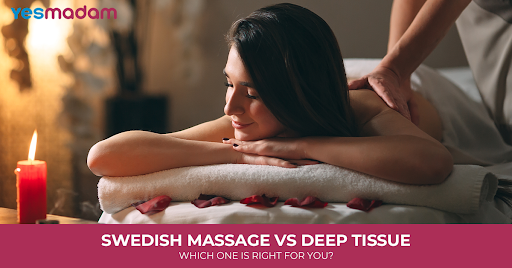
Swedish Massage vs. Deep Tissue: Which One Is Right for You?
Massage therapies, due to their dynamic techniques and unique benefits, are widely used and practiced to treat different conditions people face regularly. From promoting relaxation to other therapeutic properties, it is difficult to underestimate the impact of massage in healthcare.
The best answer to the question “Which type of massage is right for you?” ultimately depends on your individual needs and preferences.
Swedish massage and deep tissue massage are two of the most popular massage therapies, each offering distinct benefits, applications, and techniques.
This blog, Swedish Massage vs. Deep Tissue, will guide you in choosing the right massage for you by exploring the key differences between the two.
Table of Contents
Swedish Massage vs. Deep Tissue Massage: What’s the Difference?
Swedish massage is a complete body therapy to unwind and relax after a prolonged day of gruelling activities. Deep tissue massage focuses on specific body areas to ease chronic pain. To have a complete understanding of Swedish massage deep tissue massage, here are some aspects to consider:
What is a Swedish massage?

Swedish massage, also called classic massage, is the most common form of massage technique. It is a step-by-step massage process to improve blood circulation, alleviate muscle tension, and promote gentle relaxation. The pressure and strokes used in it are usually lighter, in comparison to deep tissue massage. It is thus known for its more gentle and soothing approach.
Benefits of Swedish massage
- Improved blood circulation
- Stress reduction.
- Complete mind-body relaxation
- Decreased muscle tension and soreness
- Helps the body get rid of waste products and pollutants.
Step-by-step guide on how to do a Swedish massage
A typical swedish massage includes the following steps such as :
- Kneading and rubbing your muscles
- Putting pressure on your bones and muscles
- Muscle compression and vibration
- Tapping strokes on your muscles
- Joint movements
More Information For You: Difference Between Spa And Massage
What is a deep tissue massage?

A deep tissue massage usually targets the deeper levels of muscles and connective tissues. The massage uses the same stroking and kneading motions as swedish massage, but the pressure involved in it is intense. It mainly helps relieve chronic discomfort and tightness in the muscles. This massage is a good option for those looking for a massage that is intense and revitalizing.
Benefits of deep tissue massage
- Promotes healing through relaxing the tense muscle areas and tissues.
- Helps in healing muscle injuries and minimizing inflammation.
- Promotes relaxation and stress relief through releasing endorphins.
- Reduced stiffness and muscular pain.
- Improved motion and flexibility.
A step-by-step guide to deep tissue massage techniques
The following is a step-by-step process of deep tissue massage :
1 Consultation and warm-up: To understand the client’s pain and prepare muscles using gentle strokes.
2. Intense Pressure apply: Applying slow, precise techniques such as stripping and cross-fiber friction.
3. Trigger point release: Put firm pressure on tight spots for a certain seconds to 2 minutes.
4. Stretching and reintegration: Includes soothing strokes and passive stretching to support realignment.
Don’t Miss: Balinese Massage
Difference Between Swedish Massage and Deep Tissue Massage

Although there are similarities between the two types of massage in focus, the primary difference between Swedish and deep tissue massage is in the level of pressure involved.
Here’s a more detailed breakdown:
Swedish Massage:
- Focus: Relaxation and stress relief.
- Pressure: Light to medium pressure with long, gliding strokes.
- Techniques: Includes effleurage (stroking), petrissage (kneading), friction, and tapotement (percussion).
- Benefits: Improves circulation, reduces muscle tension, promotes relaxation, and can help with minor aches and pains.
- Ideal for: Those seeking relaxation, stress reduction, or relief from minor muscle soreness.
Deep Tissue Massage:
- Focus: Addressing chronic pain, muscle tension, and injuries.
- Pressure: Firm, deep pressure with slow, deliberate strokes.
- Techniques: Uses techniques like cross-fiber friction and deep kneading to break up adhesions and release tension in deeper muscle layers.
- Benefits: Relieves chronic pain, reduces muscle stiffness, improves posture, and can help with conditions like sciatica and fibromyalgia.
- Ideal for: Those with chronic muscle pain, injuries, or those who engage in physically demanding activities.
Recommended You: Potli Massage
Swedish Massage or Deep Tissue Massage: Which Massage is Right for You?
Here’s a table outlining important factors that will help you decide between swedish massage vs. deep tissue massage.
| Factors | Swedish Massage | Deep Tissue |
| Pain management | It can help with mild pain or discomfort. | A deep tissue massage is more beneficial for chronic or targeted pain relief. |
| Relaxation | More suitable for general relaxation or relief from everyday stress. | The main goal is usually for muscle pain relief. |
| Health conditions | General muscle tension, overall wellness. | Usually targets deeper muscle layers and specific problems. |
| Personal preferences | Good for those seeking overall wellness or who are new to massage therapy. | Those who prefer profound, targeted pain relief. |
| For Athletes | Lighter pressure is good for overall athletic well-being. | Intense pressure improves athletic performance and recovery. |
| Mental Health | Good for those looking to unwind and improve overall mental health. | Good for people under chronic stress. |
Related Blog: Benefits Of Head Massage For Men
Conclusion
Now that you know the complete difference between Swedish massage vs. deep tissue, you can select the massage that best suits your needs and benefits for your health. The ultimate difference between these two popular forms of massage lies in the pressure involved, stroke style, treatment goals, targeted areas, and intended outcome. For any further queries or concerns, you can always communicate with your massage therapist to customize the massage to your specific needs.
FAQs
What’s the difference between Swedish massage and deep tissue massage?
The main difference between Swedish and deep tissue massage lies in the pressure applied and the depth of tissue targeted.
Which is better, Swedish massage or Deep Tissue massage?
Neither Swedish nor deep tissue massage is inherently “better.” The best choice depends on individual needs and preferences.
Which is the best massage for body pain?
Deep tissue massage is often recommended for chronic muscle tension and pain, while Swedish massage is good for relaxation.
Who should not get a deep tissue massage?
Deep tissue massage, while beneficial for many, is not recommended for individuals with recent injuries or surgeries, severe osteoporosis, blood clotting disorders, or some cardiovascular issues.
Is Swedish massage good for health?
Yes, Swedish massage is usually beneficial for health. It is known for promoting relaxation, enhancing circulation, and relieving muscle tension, among other benefits.
Can swedish massage and deep tissue massage be combined for optimal results?
Yes, Swedish and deep tissue massage can be effectively combined for a customized massage experience offering both relaxation and targeted pain relief.
When is a deep tissue massage better than a swedish massage?
A deep tissue massage is usually better when the goal is to treat chronic muscle pain, injuries, or postural issues.
What not to do after swedish massage vs. deep tissue?
After both Swedish and deep tissue massages, refrain from strenuous activity, hot showers or baths, alcohol, and caffeine.
How often should you do a Swedish massage or deep tissue massage?
The frequency varies as per individual goals and needs. Swedish massage can be done every 1-4 weeks, and deep tissue massage is recommended every 2-4 weeks.
What is the most requested massage, Swedish or deep tissue?
Swedish massage is generally the most requested and popular type of massage for its gentler approach and focus on relaxation and overall well-being.



